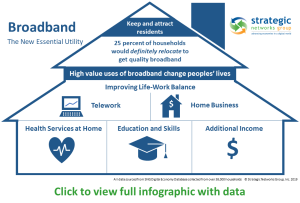Developing Broadband Policies

SNG News – Jefferson County, Oregon Secured $19M for Broadband Deployment
How Jefferson County, Oregon Secured $19M for Broadband — With a Plan Built on Local Insight and Hard Data In ...

Broadband funding is coming – but when and with what conditions? Can we wait for it?
With more and more funding for broadband – for example, the US’s $100 billion through the American ...

Unserved, underserved, or future ready – do your businesses and households have the broadband they need?
How do you reliably and accurately identify areas that are unserved, underserved, or future ready with ...

Telework and Accessing the Workplace
SNG Research Brief – Teleworking Teleworking is not for everyone, nor is it available to everyone in ...

Household Access to Robust and Competitive Broadband
SNG Research Brief – Household Broadband Access to robust and competitive broadband is essential ...

Broadband Importance to Household Location
Is quality broadband important to households? Hopefully, the obvious answer to most people is yes. But ...

Get ten times more broadband coverage per tax dollar invested
How can funding agencies get ten times more broadband coverage per tax dollar invested? – invest in ...

Invest in Digital Infrastructure, not Just Broadband Networks
There are still far too many communities without broadband and funding agencies do not have enough money to ...

Options for States and Localities to Address Broadband Gaps
States and localities know that they need to address their unserved and underserved areas, but with little or ...
